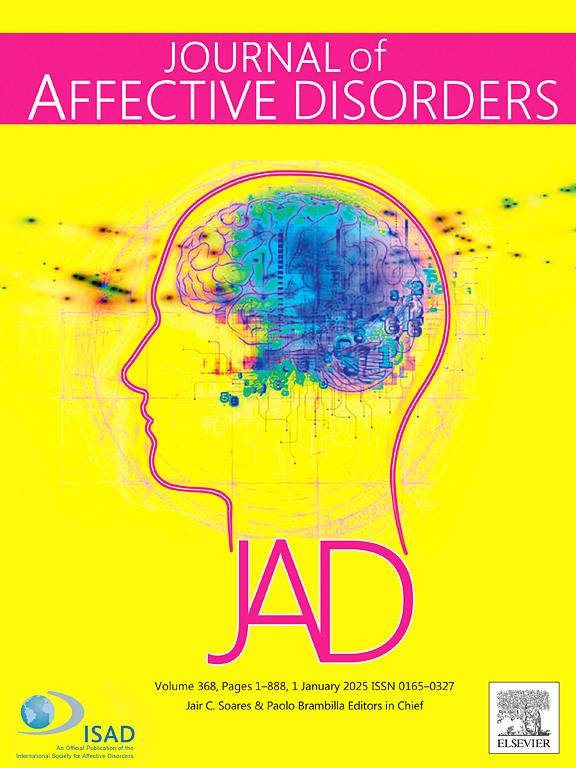具身自我感在儿童虐待类型与痛苦和恐惧关系中的作用。
IF 4.9
2区 医学
Q1 CLINICAL NEUROLOGY
引用次数: 0
摘要
理论模型表明,童年时期的虐待侵蚀了具身自我意识(ESS),这是一个多维的实体,包括主观的具身经验和叙事身份。然而,没有研究同时评估童年虐待类型对最小自我和叙事自我的影响,也没有研究考察这种综合自我感在童年虐待与精神病理关系中的作用。本横断面研究以610名大学生为研究对象,探讨了儿童期情绪虐待(CEA)、儿童期性虐待(CSA)和儿童期身体虐待(CPA)对恐惧和痛苦的中介作用。间接路径是通过总体ESS,以及通过所有权、代理和叙述的个别领域来估计的。对ESS的干扰介导了CEA和CPA与恐惧和痛苦的关系,在CEA中观察到特别强大的间接途径。CEA对所有三个ESS域都表现出强烈的影响,而从CSA到叙事,从注册会计师到所有权和代理的路径更为温和。CEA和CPA通过代理作用对痛苦产生显著的间接影响,CEA和CSA通过叙述作用对痛苦和恐惧产生显著的间接影响。在这两种模型中,只有从CEA和CSA到窘迫的直接路径。这些发现表明,儿童期虐待破坏了综合自我意识的形成,并且ESS在从儿童期虐待到内化症状的途径中的作用可能仅限于代理和叙述领域。进一步的研究应该阐明儿童虐待类型可能破坏ESS的机制。本文章由计算机程序翻译,如有差异,请以英文原文为准。

The role of embodied sense of self in the relationship of childhood abuse types to distress and fear
Theoretical models suggest that childhood abuse erodes embodied sense of self (ESS), a multidimensional entity that encompasses both subjective embodied experience and narrative identity. However, no studies have evaluated the impacts of childhood abuse types on the minimal and narrative selves simultaneously or examined the role of this integrated sense of self in the relationship of childhood abuse to psychopathology. The present cross-sectional study investigated ESS as a mediator from childhood emotional abuse (CEA), childhood sexual abuse (CSA), and childhood physical abuse (CPA) to fear and distress in a sample of 610 undergraduate students. Indirect paths were estimated through overall ESS, and through the individual domains of ownership, agency, and narrative. Disturbances to ESS mediated the relationship of both CEA and CPA to fear and distress, with particularly robust indirect paths observed for CEA. CEA demonstrated strong effects on all three ESS domains, while more modest paths appeared from CSA to narrative and from CPA to ownership and agency. Significant indirect effects emerged from both CEA and CPA through agency to distress, and from CEA and CSA through narrative to distress and fear. In both models, direct paths remained from CEA and CSA to distress only. These findings suggest that childhood abuse undermines the formation of an integrated sense of self, and that role of ESS in the pathway from childhood abuse to internalizing symptomatology may be restricted to the agency and narrative domains. Additional research should clarify the mechanisms by which childhood abuse types may disrupt ESS.
求助全文
通过发布文献求助,成功后即可免费获取论文全文。
去求助
来源期刊

Journal of affective disorders
医学-精神病学
CiteScore
10.90
自引率
6.10%
发文量
1319
审稿时长
9.3 weeks
期刊介绍:
The Journal of Affective Disorders publishes papers concerned with affective disorders in the widest sense: depression, mania, mood spectrum, emotions and personality, anxiety and stress. It is interdisciplinary and aims to bring together different approaches for a diverse readership. Top quality papers will be accepted dealing with any aspect of affective disorders, including neuroimaging, cognitive neurosciences, genetics, molecular biology, experimental and clinical neurosciences, pharmacology, neuroimmunoendocrinology, intervention and treatment trials.
 求助内容:
求助内容: 应助结果提醒方式:
应助结果提醒方式:


